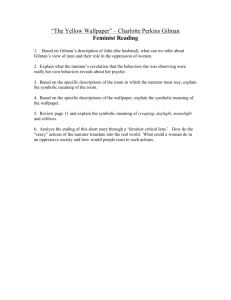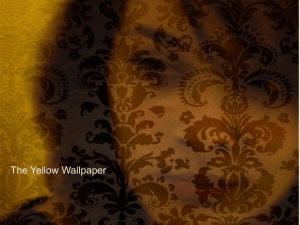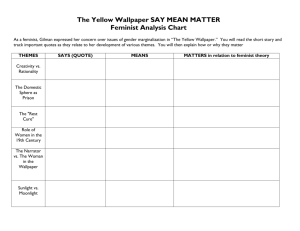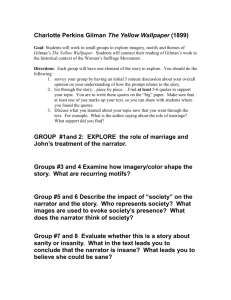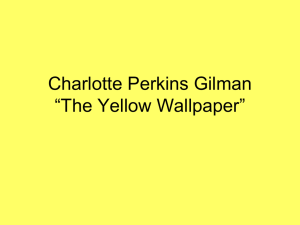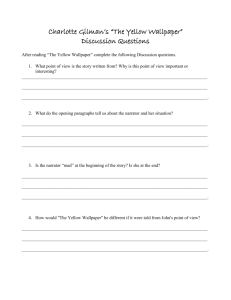Works Cited - ePortfolio
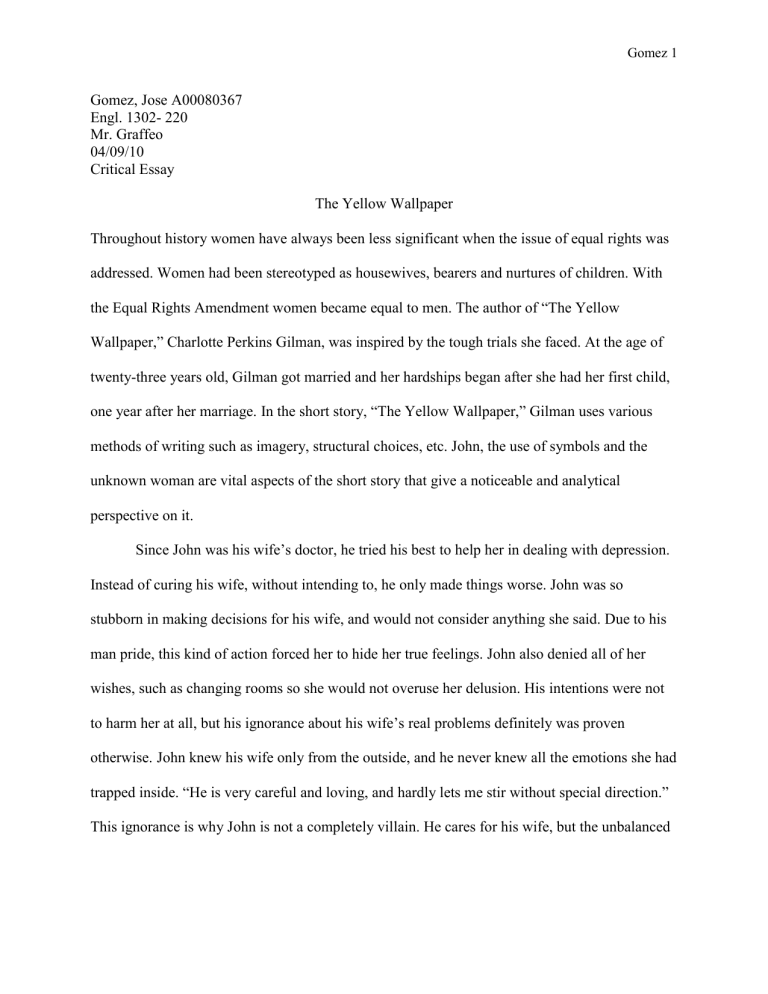
Gomez 1
Gomez, Jose A00080367
Engl. 1302- 220
Mr. Graffeo
04/09/10
Critical Essay
The Yellow Wallpaper
Throughout history women have always been less significant when the issue of equal rights was addressed. Women had been stereotyped as housewives, bearers and nurtures of children. With the Equal Rights Amendment women became equal to men. The author of “The Yellow
Wallpaper,” Charlotte Perkins Gilman, was inspired by the tough trials she faced. At the age of twenty-three years old, Gilman got married and her hardships began after she had her first child, one year after her marriage. In the short story, “The Yellow Wallpaper,” Gilman uses various methods of writing such as imagery, structural choices, etc. John, the use of symbols and the unknown woman are vital aspects of the short story that give a noticeable and analytical perspective on it.
Since John was his wife’s doctor, he tried his best to help her in dealing with depression.
Instead of curing his wife, without intending to, he only made things worse. John was so stubborn in making decisions for his wife, and would not consider anything she said. Due to his man pride, this kind of action forced her to hide her true feelings. John also denied all of her wishes, such as changing rooms so she would not overuse her delusion. His intentions were not to harm her at all, but his ignorance about his wife’s real problems definitely was proven otherwise.
John knew his wife only from the outside, and he never knew all the emotions she had trapped inside. “He is very careful and loving, and hardly lets me stir without special direction.”
This ignorance is why John is not a completely villain. He cares for his wife, but the unbalanced
Gomez 2 relationship in which they find themselves prevents him from truly understanding each other’s problems (Gilman, 1892).
The unknown woman from the short story, “The Yellow Wallpaper,” is a young upper middle class woman who suffers from postpartum depression. This illness gives her insight into her condition in society and in marriage. In the very beginning of the short story, one can see that the narrator is showing imagination and its expression herself. She started remembering when she used to terrify herself with imaginary nightmares, and started believing that the house they were in was haunted. As part of her cure, her husband John prohibits her to exercise her imagination. “That spoils my ghostliness, I am afraid, but I don’t care-there is something strange about the house-I can feel it.” Both her reason and her emotions rebel at this treatment, and she turns her imagination into neutral objects, the house and the wallpaper, in an attempt to ignore her growing frustration. Her negative feelings color her insight description of her surroundings, making them seem uncanny and sinister, and she becomes obsessed with the wallpaper (Gilman,
1892).
“The Yellow Wallpaper” is driven by the narrator’s sense that the wallpaper is a text she must interpret, that it symbolizes something that affects her directly. Accordingly, the wallpaper develops its symbolism throughout the story. At first it seems only unpleasant: it is ripped, soiled, and an unclean yellow. “The color is repellent, almost revolting: a smouldering unclean yellow, strangely faded....” The worst part is the supposedly unshaped pattern, which fascinates the narrator as she attempts to figure out how it is organized. “It is dull enough to confuse the eye in following, pronounced enough constantly to irritate and provoke study....”After staring at the paper for hours, she sees a ghostly sub-pattern behind the main pattern, visible only in certain light. Eventually, the sub-pattern comes more clearly as a desperate woman, constantly crawling
Gomez 3 and stooping, looking for an escape from behind the main pattern, which has come to resemble the bars of a cage. The narrator sees this cage as festooned with the heads of many women, all of whom were restrained as they tried to escape. Clearly, the wallpaper represents the structure of family, medicine, and tradition in which the narrator finds herself trapped. Wallpaper is domestic and humble, and Gilman skillfully uses this terrifying, hideous paper as a symbol of the domestic life that traps so many women (Gilman, 1892).
John’s ignorance towards his wife’s inner feelings and the unknown woman’s frustration toward the wallpaper set up a vital point of view to the readers. Apparently, John, the unknown woman and the symbolism throughout the story build up some critical and analytical factors from “The Yellow Wallpaper.”
Gomez 4
Works Cited
Caruso, G. (2002-2010). Helium . Retrieved March 29, 2010, from Arts and Humanties:
Literature: http://www.helium.com/items/536002-literary-analysis-the-yellow-wallpaperby-charlotte-perkins-gilman
Gilman, C. P. (1892). The Yellow Wallpaper.
New England.
Wolfe, J. (2006, March 06). Symbolism . Retrieved March 29, 2010, from Arts and
Entertainment: http://www.associatedcontent.com/article/21620/symbolism_in_the_yellow_wallpaper_b y.html?cat=38

